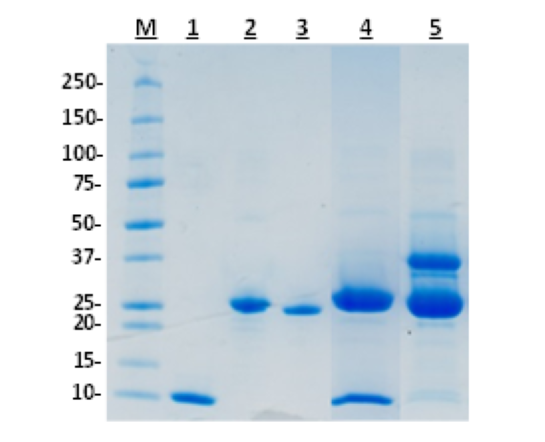SiMPLe Protein Labeling Kit (Sortase Mediated Protein Ligation)
The SiMPLe Protein Labeling Kit (Sortase Mediated Protein Ligation) is a kit designed to label recombinant antibodies or proteins that contain the sortase recognition sequence, making use of the highly active Sortase A Pentamutant and resulting in a labeling efficiency of greater than 90%. This kit provides enough reagents, including purification columns to remove Sortase A Pentamutant and excess label, to label 3 x 100 μg of recombinant antibody/protein. Ubiquitin-LPETGH6 and GGG-Clover are included as positive controls.

Figure 1: Schematic of the mechanism of action used in the SiMPLe Protein Labeling Kit (Sortase Mediated Protein Ligation).
The combination of your protein of interest with Sortase A Pentamutant and a poly-glycine label results in a labeled protein, when incubated for 30 minutes at 37°C. This labeled protein can then be purified
- Target Protein (1 mg/ml, 100 μg per reaction)
- Poly-glycine label (5 mM, 5 µl per reaction, <10 kDa)
- Microcentrifuge
- Buffer for final formulation (such as PBS or TBS)
- 37°C incubator
| Catalog # | Name | Amount | Storage |
| 71046 | Sortase A Pentamutant, S. aureus, His-Tag* | 3 vials (1U/vial) | -80°C |
| 79394 | Reaction Buffer | 100 µl | 4°C |
| 79395 | Stop Solution | 200 µl | 4°C |
| 79396 | Purification Columns | 3 | Room Temp |
| 79397 | Collection Tubes | 6 | Room Temp |
| 79398 | Ubiquitin-LPETGH6 | 1 vial | -80°C |
| 79399 | GGG-Clover | 1 vial | -80°C |
*The concentration of the protein is lot-specific and will be indicated on the tube.
Sortases catalize a transpeptidation reaction, where the enzyme cleaves the amide bond between the threonine and glycine of the sortase recognition sequence (LPXTG for S. aureus Sortase A), generating a thioacyl intermediate. Subsequently, this intermediate is resolved by the N-terminus of an oligoglycine nucleophile, creating a new peptide bond that links the substrate to the incoming nucleophile.
Popp M., 2015 Methods Mol Biol. 1266:185-98.


